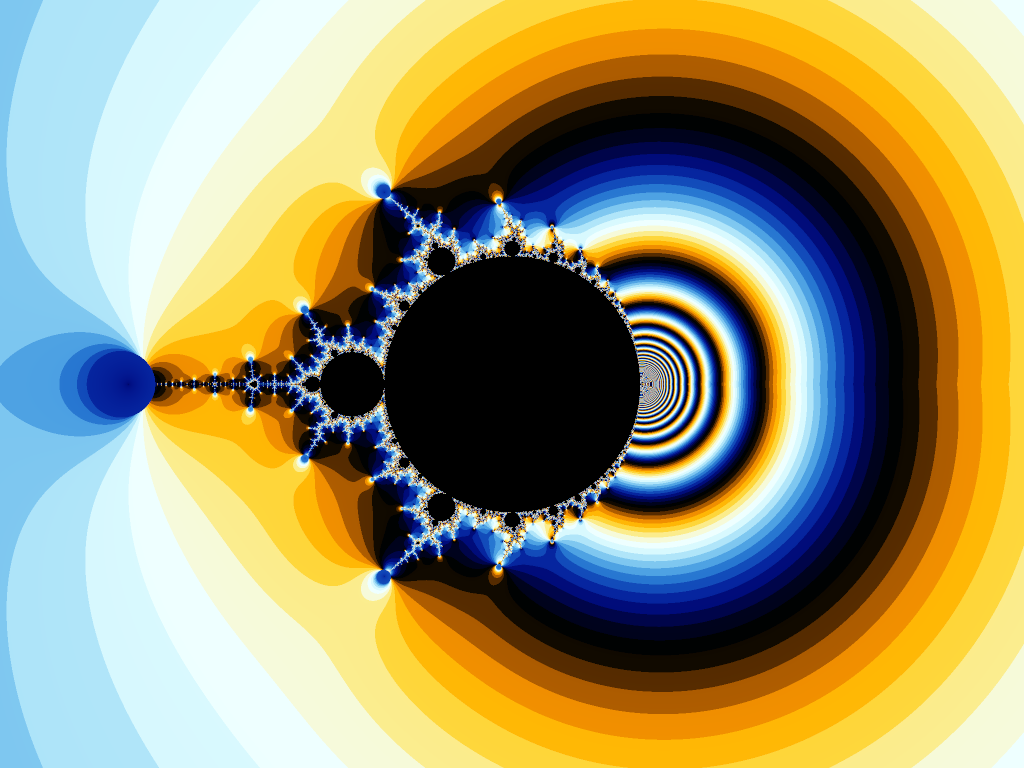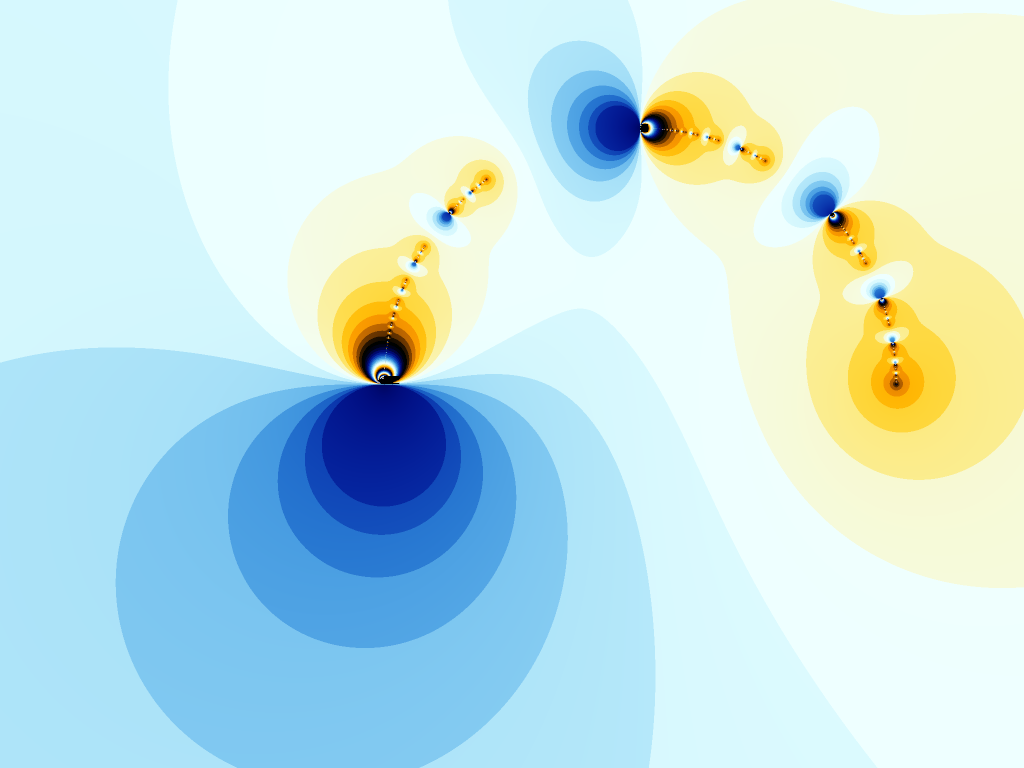On the boundary of the central quadratic
hyperbolic component
1112010 Mathematics Subject Classification: 37F10, 37F20
Abstract
We give a concrete description for the boundary of the central quadratic hyperbolic component. The connectedness of the Julia sets of the boundary maps are also considered.
1 Introduction
Let denote the complex orbifold of holomorphic conjugate classes of rational maps of degree . A rational map is hyperbolic if the orbit of every critical point converges to attracting (or super-attracting) periodic cycles under iteration. Hyperbolic maps form an open subset of and conjecturally they are dense in [7]. A connected component of this open subset is called a hyperbolic component. Any two maps in the same hyperbolic component are quasiconformally conjugate in a neighborhood of their Julia sets [7].
The hyperbolic components of quadratic rational maps have been intensively studied and fruitful results have been obtained. For example, Rees [9] gave a classification of the hyperbolic components (see also [5]), and proved the boundedness of certain one real dimension loci in hyperbolic components. Epstein [4] provided a boundedness result for a hyperbolic component of quadratic rational maps possessing two distinct attracting cycles. The closure of the set of quadratic rational maps having a degenerate parabolic fixed point was investigated by Buff-Écalle-Epstein in [2].
In this work, we consider the boundary of the hyperbolic component in containing , which is called the central quadratic hyperbolic component. Every rational map in has two fixed attracting (or super-attracting) points and its Julia set is a quasicircle.
Each quadratic rational map has exactly three fixed points (counting the multiplicity). Let be the eigenvalues at fixed points. These three eigenvalues determine the quadratic rational map up to holomorphic conjugacy ([5, Lemma 3.1]). If the three fixed points are distinct, then by the Rational Fixed Point Theorem ([6, Theorem 12.4]), we have
| (1) |
If a quadratic rational map has at least two distinct fixed points, conjugating the map by a Möbius transformation if necessary, we may assume that and are the two fixed points and the eigenvalues at them are and respectively. Thus the holomorphic conjugacy class of the map can be represented by
with . Note that is holomorphically conjugated to . Therefore the central quadratic hyperbolic component can be expressed by
where denotes the unit disk.
Recall that
where denotes the Julia set of . One may refer to [1, 5, 8] for more properties about , see Figure 1 for a picture of parameterized by the eigenvalue of the other fixed point.

Denote
From the definitions, we easily make the following deductions.
-
(a)
Obviously, , and are pairwise disjoint.
For any , either has three distinct fixed points or has no repelling fixed points. Note that
where . So for any , either has exactly two fixed points and one of them is repelling, or has a unique fixed point. Thus .
-
(b)
It is clear that and .
-
(c)
By [5, Lemma 8.2], for any , either is connected or is a Cantor set. In the latter case, both critical orbits of converge to an attracting or a parabolic fixed point. If , then has two distinct non-repelling fixed points. Thus is connected. Actually, is the closure of the central component of the interior of .
Our main result is the following.
Theorem 1.1.
The following statements hold:
-
(1)
;
-
(2)
;
-
(3)
.
Remark. 1. We highly appreciate that the referee makes us aware of Buff-Epstein’s example which illustrates that
where is parameterized by the eigenvalue of the other fixed point. Refer to [1, pp. 272: Example]. Theorem 1.1 (2) could be obtained directly by their illustration, and moreover, one could conclude that
from their example.
In Section 3, we exploit twist surgery to prove
which is the main part of this work.
To prove Theorem 1.1 (3), we discuss the boundedness of in Section 4 and give a bound on in Lemma 4.1. The bound given by Buff-Epstein is stronger than Lemma 4.1. We would like to point out that, compared to their result, Lemma 4.1 is obtained by quite simple and elementary computations. For self-containedness, we include Lemma 4.1 in this article.
Obviously, by Theorem 1.1 (1).
2. One typical way to produce boundary maps of hyperbolic components is pinching. It is proved in [3] that under certain conditions, the pinching path starting from a geometrically finite rational map converges uniformly to a geometrically finite rational map , and the quasiconformal conjugacy from to converges uniformly to a semi-conjugacy from to . Moreover, , where is defined as if is quasiconformally conjugate to in a neighborhood of the Julia sets.
It turns out that any geometrically finite rational map with is the limit of a pinching path starting from a rational map in . By Theorem 1.1 (2), if , then is disconnected. Thus it can not be obtained by pinching from .
2 A direct description of
In this section, we give a direct description of the boundary by a basic discussion.
Lemma 2.1.
For any , let be the eigenvalue of at the unique repelling fixed point. Then .
Proof.
Let . Then maps onto . Combining with the equation (1), we have
So and hence . ∎
Lemma 2.2.
Let be quadratic rational maps with eigenvalues at the fixed points. Then converges to in if and only if by a suitable ordering, converges to in , where are the eigenvalues of at the fixed points.
Proof.
Assume that converges to in . Since always has a fixed point with non-zero eigenvalue, we may represent by
with . Note that is holomorphically conjugate to .
As is large enough, . So can also be represented by
Consequently, converges to as .
The eigenvalues of the other two fixed points of are
| (2) |
Thus converges to since converges to .
Conversely, assume converges to in . Then at least one of them, say is non-zero. Thus as is large enough, . As above, can also be represented by . By equation (2), we have
From the condition converges to in , we obtain converges to . This yields that is convergent in . ∎
The reader may also refer to [5, Section 3] or [4, Lemma 3] for the above lemma. The statement here is slightly different from them.
Lemma 2.3.
The following statements hold:
-
(i)
;
-
(ii)
.
Proof.
(i) Assume that . Then there is a sequence in which converges to . Let () be the eigenvalues of at the three fixed points with . Then converges to in by Lemma 2.2.
If or , then the two attracting fixed points of converge to two distinct fixed points of . Moreover . Thus . If , then by Lemma 2.1. Thus . Now we have proved .
(ii) For any , one can choose a sequence in which converges to . Thus . ∎
3 Dynamics of maps in
In this section, we will apply twist deformation to study the dynamics of maps in .
Let with . Denote by the set of points in the Fatou set with infinite forward orbits. Then the quotient space is a disjoint union of two tori and under the equivalence relation if for some integers . Denote by the natural projection. Then each torus contains a unique point such that , where and are the critical points of .
By the Koenigs Linearization Theorem ([6]), for , there is a conformal map , where is the lattice generated by and with , such that for any simple closed curve corresponding to , each component of is a Jordan curve in if is disjoint from the point .
For , let be a simple closed curve such that is homotopic to the curve corresponding to in . Then each component of is an open arc. In particular, has a unique component whose endpoints contain the attracting fixed points.
Let be the Dehn twist along . We will consider the quasiconformal deformation of whose projection to realizes the repeated Dehn twist . Such quasiconformal deformation can be defined as follows.
Take an annulus for , such that consists of two disjoint simple closed curves homotopic to in . Let be a conformal map from onto . Define a quasiconformal map from onto itself by
Now we define
For every , let be the Beltrami differential of . Let be the pullback of under , i.e.,
Then there exists a quasiconformal map with Beltrami differential . Set . Then is a rational map. We call a twist sequence of along .
Theorem 3.1.
The twist sequence converges to as , where satisfies
| (3) |
and . Conversely, any is the limit of a twist sequence in .
Proof.
Denote by () the eigenvalues of at the two attracting fixed points. The quotient space of is the disjoint union of two tori and . By the Koenigs Linearization Theorem, for , is holomorphically isomorphic to , where is the lattice generated by and with . Since is the quasiconformal deformation of whose projection to realizes the repeated Dehn twist , we have is also holomorphically isomorphic to , where is the lattice generated by and , for . Thus
Equivalently, we have
Thus
and as . Note that
Thus
where denotes the eigenvalue of at the repelling fixed point. Let . Then the equation (3) holds.
Since , converges to . Note that . Thus for . By the equation (3), we have . So and hence .
Conversely, notice that the map
from to is surjective. Thus for any with , there exist with , such that
Choose and . Let be the twist sequence of along . Then converges to by previous argument. ∎
Lemma 3.2.
For any , is a Cantor set.
Proof.
We will exploit the process of the twist deformation as above to study the dynamics of . Denote the two invariant attracting Fatou domains of by and . Denote . Then both and are domains containing a critical orbit by the choice of . The quasiconformal map is conformal in for . We normalize by fixing the repelling fixed point of and two points in the backward orbit of it such that converges uniformly to . Since such three points are not contained in , the sequence is a normal family in . Thus there exists a subsequence locally uniformly convergent to a map defined on which is either conformal or a constant. If is a constant in some , then one of the critical point of is a fixed point. This is impossible. Thus is conformal in and . Therefore is contained in an invariant Fatou domain of . So each of the two critical points of lie in an invariant Fatou domain of . Note that has no attracting fixed points. So both of the critical points lie in the fixed parabolic Fatou domain. Thus is a Cantor set [5, Lemma 8.1]. ∎

In order to illustrate the deformation of the dynamics of the twist sequence and its limit map near the Julia sets, we choose a map such that . Then
i.e., is symmetric about the unit circle and is the unit circle.
Since , we may choose such that , and . Let be the eigenvalues of the attracting fixed points of the twist sequence of along . Then by the definition of twist deformation. Thus is also symmetric about the unit circle. By making a holomorphic conjugacy, we may choose a representative such that is still symmetric about the unit circle, but the two attracting fixed points of are and . Then as , uniformly converges to a quadratic rational map . See Figure 2 for the dynamics of and Figure 3 for the dynamics of near Julia sets.

4 The boundedness of
We may parameterize by its eigenvalue at another fixed point.
Lemma 4.1.
.
Proof.
Each map in can be represented by with . The infinity is a parabolic fixed point of with eigenvalue . When , has no other else fixed point. Otherwise, is the another fixed point of with eigenvalue . Thus is holomorphically conjugate to for .
Assume . From
we see that if and , then
Thus
and hence .
Inductively, we obtain that if and , then and for all . Consequently as .
The critical points of are located at and the corresponding critical values are . Thus when , we have and
Therefore the two critical points of converges to the infinity. So is disconnected. Thus if , then is disconnected. Now the lemma is proved. ∎
Proof of Theorem 1.1.
Combining Lemma 2.3, Theorem 3.1 and Lemma 3.2, we derive the statements (1) and (2) in Theorem 1.1.
From (1) and (2), we have . Lemma 4.1 shows that . ∎
Acknowledgements. The authors would like to express the sincere gratitude to the anonymous referee for all the valuable and helpful suggestions and comments.
References
- [1] X. Buff and A. Epstein, A parabolic Pommerenke-Levin-Yoccoz inequality, Fundamenta Mathematicae, 172 (2002), 249-289.
- [2] X. Buff, J. Écalle and A. Epstein, Limits of degenerate parabolic quadratic rational maps, Geom. Funct. Anal. 23 (2013), No. 1, 42-95.
- [3] G. Cui and L. Tan, Hyperbolic-parabolic deformations of rational maps, Sci. China: Math., 61 (2018), No. 12, 2157-2220.
- [4] A. Epstein, Bounded hyperbolic components of quadratic rational maps, Ergodic Theory Dynam. Systems, 20 (2000), No. 3, 727-748.
- [5] J. Milnor, Geometry and dynaimcs of quadratic rational maps, With an appendix by the author and Lei Tan, Experiment. Math., 2 (1993), No. 1, 37-83.
- [6] J. Milnor, Dynamics in One Complex Variable, 3rd edition, Princeton University Press, 2006.
- [7] R. Mañe, P. Sad and D. Sullivan, On the dynamics of rational maps, Ann. Sci. Éc. Norm. Sup. 16 (1983), 193-217.
- [8] C. L. Petersen and P. Roesch, The Parabolic Mandelbrot Set, arXiv:2107.09407v1.
- [9] M. Rees, Components of degree two hyperbolic rational maps, Invent. Math., 100 (1990), 357-382.
Guizhen Cui
School of Mathematical Sciences,
Shenzhen University, Shenzhen, 518052, P. R. China
and
Academy of Mathematics and Systems Science,
Chinese Academy of Sciences, Beijing, 100190, P. R. China.
[email protected]
Wenjuan Peng
Academy of Mathematics and Systems Science,
Chinese Academy of Sciences, Beijing 100190, P. R. China.
[email protected]